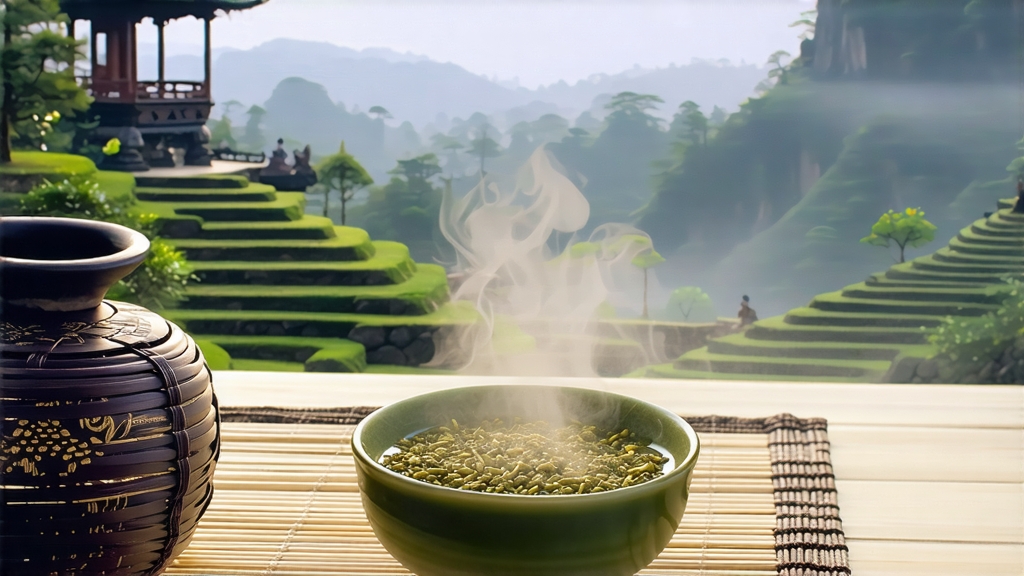
Tucked high on the mist-veiled shoulders of Mt. Meng in Sichuan province, Meng Ding Huang Ya—“the yellow bud from the summit of Meng”—has whispered its gentle fragrance across thirteen centuries of Chinese history. Unlike the verdant immediacy of green tea or the assertive darkness of pu-erh, this rare yellow tea occupies a liminal realm: it is oxidised just enough to shed grassiness, yet sealed in a warm embrace that coaxes out mellow sweetness and a colour reminiscent of late-afternoon sunlight. To international drinkers accustomed to the binary of “green or black,” Meng Ding Huang Ya offers a third, subtle path—one that once travelled only on the tongues of emperors.
Historical scrolls first name the tea during the Tang dynasty (618-907 CE), when Buddhist monks on Mt. Meng, itself deemed the “cradle of world tea culture,” tendered the earliest spring buds to court officials. By the Song era the leaves had become imperial tribute; legend claims that Emperor Xiaozong reserved the entire first-week harvest for ancestral rites, forbidding commoners from picking even a single sprout. When the Ming court later shifted its favour to roasted green teas, Meng Ding Huang Ya retreated into monastic obscurity, surviving only because local hill farmers continued a micro-scale ritual of hand-making tiny batches for Daoist healers who believed the bud balanced the five elements. Thus the tea slipped quietly into the twentieth century, a living fossil unknown even to most Chinese consumers until the 1980s revival when government agronomists “rediscovered” the technique in the memories of three octogenarian widows who still knew the secret of men-huang—“sealed yellowing.”
Today the tea is harvested exclusively from six high-elevation villages that ring the summit at 1,200–1,400 m. The cultivar of choice is the local “Meng Ding #9,” a seed-propagated shrub whose small, oval leaves concentrate amino acids under the stress of cool nights and thin mountain air. Plucking occurs only between Qingming and Grain Rain (early to late April) when each bud has reached the ideal “sparrow’s tongue” length of 12–15 mm but has not yet unfurled into a leaf. A skilled picker can gather barely 500 g of fresh buds in a day; 5 kg of these are required to yield 1 kg of finished tea, explaining why Meng Ding Huang Ya often retails for more than top-grade Longjing.
The craft sequence follows five meticulous steps that straddle green and yellow traditions. Sha-qing (“kill-green”) begins within minutes of plucking: buds are tossed into a bamboo drum roaster set at 160 °C for 90 seconds, just long enough to halt oxidative enzymes while preserving a faint emerald hue. Next comes the signature men-huang: the warm buds are wrapped in layers of steamed yellow kraft paper and placed inside a cedar box where they rest for 48 hours at 35 °C and 75 % humidity. During this humid slumber the leaf pigments gently shift from chlorophyll green to straw yellow, while non-enzymatic browning generates notes of steamed corn, fresh hay, and a hint of toasted sesame. A second, lower-temperature roasting (85 °C for 20 minutes) fixes the colour and reduces moisture to 10 %. Finally the buds are hand-sorted on a rattan tray: any stem longer than 2 mm is tweezed away, and only buds that can stand upright on their cut base—proof of perfect plumpness—are deemed worthy of the Meng Ding Huang Ya name.
Western tea lovers sometimes confuse the process with light oolong oxidation, yet the chemistry is distinct. High-performance liquid chromatography reveals that men-huang doubles the content of soluble theaflavins while cutting catechin astringency by 30 %, yielding a liquor that is simultaneously sweeter and more layered than green tea but without the floral swagger of oolong. The aroma profile contains unusual lactones such as jasmine lactone and cis-3-hexenyl hexanoate, compounds rarely found above trace levels in other tea types; researchers attribute their formation to the precise humidity window maintained during sealed yellowing.
To brew Meng Ding Huang Ya respectfully, one must think like the mountain: cool, slow, and vertical. Begin with spring water brought to 80 °C; anything hotter will scorch the bud’s downy tip. Measure 3 g of tea